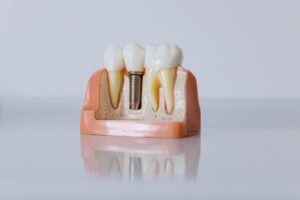 Dental implants have become a popular tooth replacement method over the last several decades. More than 500,000 Americans choose dental implants every year. Did you know that they aren’t a new innovation? Historians have found evidence of dental implants dating back to 600 AD. Early civilizations used seashells, bones, animal teeth, and other materials that weren’t successful. However, early dental implants paved the road for their success, allowing them to now be the most reliable method of treating tooth loss. Here are just a few ways dental implants have evolved to provide the unmatched results they offer today.
Dental implants have become a popular tooth replacement method over the last several decades. More than 500,000 Americans choose dental implants every year. Did you know that they aren’t a new innovation? Historians have found evidence of dental implants dating back to 600 AD. Early civilizations used seashells, bones, animal teeth, and other materials that weren’t successful. However, early dental implants paved the road for their success, allowing them to now be the most reliable method of treating tooth loss. Here are just a few ways dental implants have evolved to provide the unmatched results they offer today.
Advanced Imaging Technology
A dental implant differs from traditional bridges and crowns because it replaces both the tooth root and the crown. As a result, a healthy jawbone is essential to support dental implants.
Traditional film X-rays give dentists important information about a patient’s dental health, but they don’t show everything. The development of CT scans provides dentists with a complete picture for diagnosis and treatment planning.
Dentists can see every detail of the oral structures to look for any concerns, like infections or bone loss. They can also determine the best locations to insert dental implant posts.
Computer-Guided Placement
Computer-guided technology works with CT imaging to take the guesswork out of dental implant placement. The elite technology allows dentists to place implants with pinpoint accuracy to ensure the best results.
Titanium Implants
Titanium is most noted for the success of dental implants. The lightweight and durable material is also biocompatible. In the 1950s, a Swedish doctor discovered titanium’s ability to stimulate new bone growth, allowing the material to stay in place potentially forever.
Bone fuses with titanium through a process called osseointegration, providing unmatched support and stability for implant restorations. There’s no risk of allergic reaction from metal sensitivities.
Titanium allows dental implants to have over a 95% success rate. They are proven to last for 30 years or more with good oral hygiene and regular dental care.
Ceramic Restorations
Ceramic resembles enamel to create prosthetic teeth that look natural. Your implant dentist can design your new teeth to match your color, size, and shape preferences. Your restoration is attached to your implant using an abundant. Your results will look natural and only a trained dental professional will know it is not a real tooth.
Although it has taken centuries for dental implants to evolve into the best solution for tooth loss, each new improvement along the way has led to the only method of recreating the entire tooth structure.
About Dr. Pereira
Dr. Pereira earned her dental degree from the Tufts School of Dental Medicine and has continued her education in dental implants, cosmetic dentistry, and many other specialties. She strives to help each patient achieve their best smile using the latest solutions in dentistry. Request an appointment through her website or call her office at (781) 272-0441.







